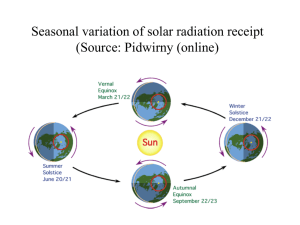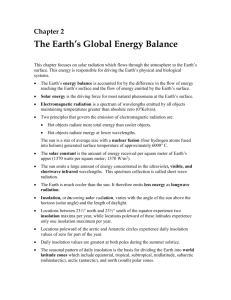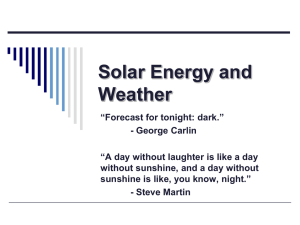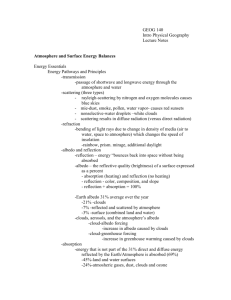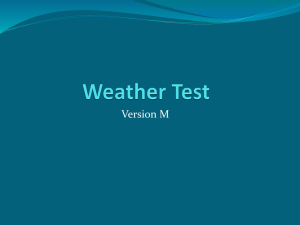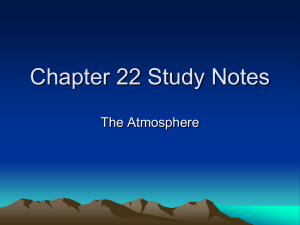AS Geography - i-study.co.uk: homepage
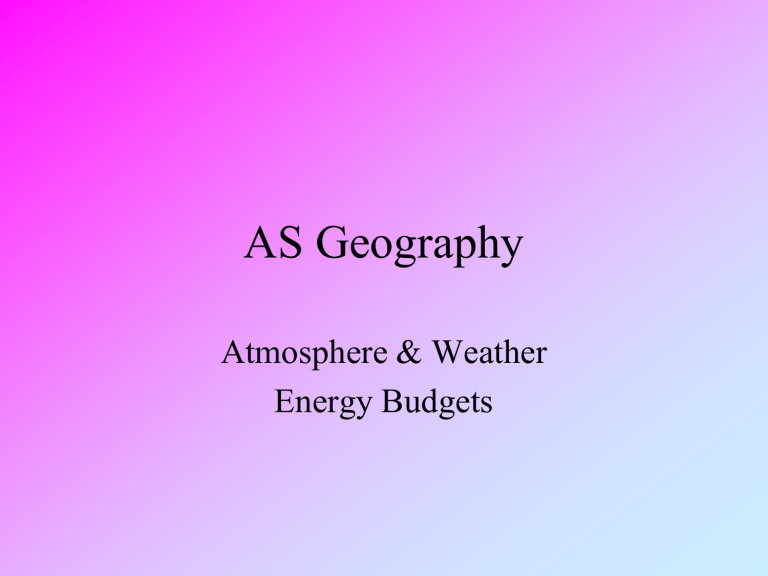
AS Geography
Atmosphere & Weather
Energy Budgets
• Meteorology is the study of the atmosphere.
• Weather is the short term conditions of the atmosphere.
Instrument
Thermometer
Hygrometer
Barometer
Anemometer
Weather Vane
Rain Gauge
Measures
Temperature
Humidity
Air Pressure
Wind Speed
Wind Direction
Rainfall/precipitation
Unit
Celsius/ Fahrenheit
%
Mb (milibars)
Km or Miles/hour
Compass directions mm
• Climate is the longer-term average conditions in the atmosphere (temperature, humidity, precipitation).
Structure of the atmosphere
Incoming & Outgoing Energy
• Energy enters the atmosphere as short wave solar radiation (insolation).
• It may leave as:
– Reflected solar radiation
– Outgoing long-wave
(infra-red) radiation
• There is a balance between the energy arriving & leaving.
• Positive heat balance at tropics
• Negative heat balance at polar regions
Energy Budgets
• Some parts of the earth receive a lot of solar energy
( surplus ), some receive less ( deficit ).
• In order to transfer this energy around, to create some sort of balance, the earth uses pressure belts , winds and ocean currents .
• The global energy budget is an account of the key transfers which affect the amount of energy gain or loss on the earth’s surface.
• The energy budget has a huge effect on weather and climate.
The six-factor day model
1. Incoming solar radiation
• Atmosphere’s main energy input
• Strongly influenced by cloud cover and latitude
• At the equator, the sun’s rays are more concentrated than at the poles.
2. Reflected solar radiation
• The proportion of reflected solar radiation varies greatly with the nature of the surface.
• The degree of reflection is expressed as either a fraction on a scale of 0 to 1, or as a percentage.
• This fraction is referred to as the albedo of the surface.
Albedo
• This is simply the proportion of sunlight reflected from a surface.
• Fresh snow & ice have the highest albedos, reflecting up to
95% of sunlight.
• Ocean surfaces absorb most sunlight, and so have low albedos.
Fresh snow
Thick clouds
Thin clouds
Ice
Sand
Earth & atmosphere
Mars (planet, not bar)
Grassy field
Dry, ploughed field
Water
Forest
Moon
Surface or object
Examples
Albedo (% solar radiation reflected)
75-95
60-90
30-50
30-40
15-45
30
17
25
15
10
10
7
3. Surface absorption
• Energy arriving at the surface has the potential to heat that surface
• The nature of the surface has an effect, e.g.
– If the surface can conduct heat rapidly into the lower layers of the soil its temperature will be low.
– If the heat is not carried away quickly it will be concentrated at the surface & result in high temperatures there.
4. Latent heat (evaporation)
• The turning of liquid water into vapour consumes a considerable amount of energy.
• When water is present at the surface, a proportion of the incoming solar radiation will be used to evaporate it.
• Consequently, that energy will not be available to raise local energy levels and temperatures.
Energy & transfers of state
5. Sensible heat transfer
• This term is used to describe the transfer of parcels of air to or from the point at which the energy budget is being assessed.
– If relatively cold air moves in, energy may be taken from the surface, creating an energy loss.
– If warm air rises from the surface to be replaced by cooler air, a loss will also occur.
• This process is best described as convective transfer , and during the day it is responsible for removing energy from the surface and passing it to the air.
6. Longwave radiation
• This is emitted by the surface, and passes into the atmosphere, and eventually into space.
• There is also a downward-directed stream of long-wave radiation from particles in the atmosphere
• The difference between the 2 streams is known as the net radiation balance .
• During the day, since the outgoing stream is greater than the incoming one, there is a net loss of energy from the surface.
Simple daytime energy budget equation
• Energy available at surface
=
Solar radiation receipt
–
(reflected solar radiation + surface absorption + latent heat + sensible heat transfer + longwave radiation)
The four-factor night model
1. Longwave radiation
• During a cloudless night, little longwave radiation arrives at the surface of the ground from the atmosphere
• Consequently, the outgoing stream is greater and there is a net loss of energy from the surface.
• Under cloudy conditions the loss is reduced because clouds return longwave radiation to the surface, acting like a blanket around the earth
• With clear skies, temperatures fall to lower levels at night.
2. Latent heat (condensation)
• At night, water vapour in the air close to the ground can condense to form dew because the air is cooled by the cold surface.
• The condensation process liberates latent heat, and supplies energy to the surface, resulting in a net gain of energy.
• However, it is possible for evaporation to occur at night. If this happens on a significant scale a net loss of energy might result.
3. Subsurface supply
• The heat stored in the soil and subsoil during the day can be transferred to the cooled surface during the night.
• This energy supply can offset overnight cooling, and reduce the size of the night-time temperature drop on the surface.
4. Sensible heat transfer
• Warm air moving to a given point will contribute energy and keep temperatures up.
• By contrast, if cold air moves in energy levels will fall, with a possible reduction in temperature.

